 Espionage has been a tool of governments for millennia. The modern origins of fictional spycraft begin with Joseph Conrad’s short story, “The Secret Agent”, and the organization of modern agencies dedicated to covert intelligence operations during World War II. This became fodder for Ian Fleming’s character of James Bond and the image of a suave, charismatic covert agent was born. Covert is a new game from Kane Klenko that seeks to tap into the fascination with the subject with a play style set to match the topic.
Espionage has been a tool of governments for millennia. The modern origins of fictional spycraft begin with Joseph Conrad’s short story, “The Secret Agent”, and the organization of modern agencies dedicated to covert intelligence operations during World War II. This became fodder for Ian Fleming’s character of James Bond and the image of a suave, charismatic covert agent was born. Covert is a new game from Kane Klenko that seeks to tap into the fascination with the subject with a play style set to match the topic.
Game Overview:
Covert melds together a theme of secret agencies operating in post-WWII Europe aiming to complete a variety of missions. Players will need to manage dice-as-workers, placing them on various spots to move agents to locations and gather resources. This couples with some light puzzle-solving masquerading as code breaking and the disruptive influence of other players to create the right feel for a spy-vs-spy game. The player who best breaks codes and completes the most valued missions is declared the winner.
Game Components:

Covert has some of the best components in terms of design and imagery, but also one of the most annoying. The care and attention to production of the graphics and art in the game really highlight the one disappointment present.
The game contains a board representing European cities connected through string paths, locations for dice placement, and two rows of spaces for numbered “Cipher” tokens. The creativity in design and representation of spaces with just the right texture and evocative imagery such as dingy file folders, scraps of paper, and handwritten fonts is omnipresent. The attention to detail here is admirable.
The art included with other components is equally well designed with icons for ease of use and full images, such as the resources on Agency cards (the main cards in the game) to further engage with the theme. Player shields are well sized for their task and the dice use a Courier type font for their numbers, keeping with the post-World War II espionage theme. Also magnificent are the combination-lock style code cards which are used with the “Cipher” tokens to gain small points for each code completed. A good quality cloth bag containing cardboard “Special Operations” tokens is also present.
Covert also excels with its rulebook. Very few other rules manuals are laid out with such attention to theme and careful consideration for how players reference rules. Separate boxes in the rules highlight the major rules and noted exceptions. Overall it was easy to find information and an aid in teaching.
Furthermore, the game producers went to exceptional lengths to engage players as noted by including multiple ciphers on the lower game box and the back cover of the rules. Even the title on the side of the top game box appears white, but reveals the game title when light is reflected from the side. Such a commitment to the theme is refreshing.
The one frustration comes with the wooden components. The cubes representing “Intel” are fine, but the meeples for the agents on the board are tremendously oversized causing more than one player to assume that only one player can be on a space at a time. Smaller pawns or meeples of half the size could have sufficed with a representation that would be just as thematic. It’s annoying enough to make players want to swap them out after one game.
How to Play:
After setup, player order in Covert is randomized with a dice roll at the beginning, and during the game, the first person to drop out of a round becomes first player. After this initial dice roll, game rounds are composed of three distinct steps: dice placement, code breaking, and dice resolution.
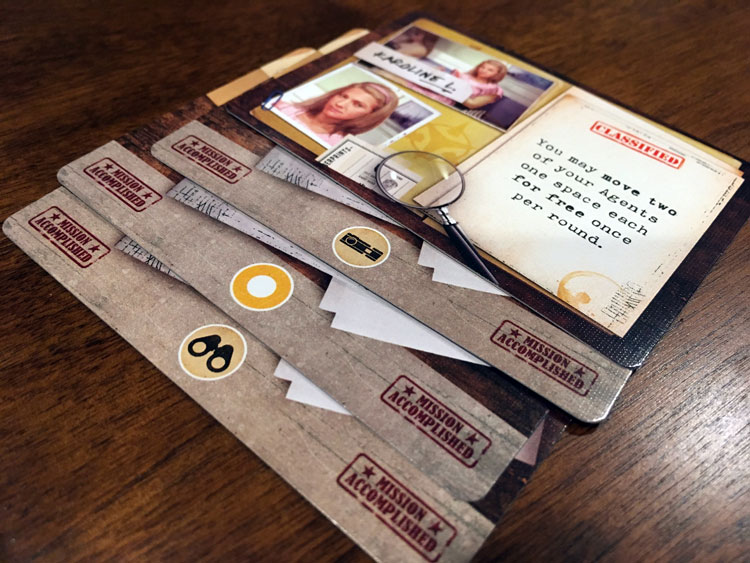
Dice placement proceeds with players allocating their five randomly rolled dice to six different locations on the main board. Dice placed at the Cipher rows allows players to aid players matching numbers with their Code cards. Dice that go to Special Operations provide random draws from the bag of associated tokens. These provide special abilities during the dice resolution phase.
The four major dice placement sections at the top of the board are for moving agents, taking Agency cards, taking Mission cards, and completing missions. Any die placed must be placed next to an existing die by number unless it is the first die placed. These dice will be removed during the dice resolution step and actions taken.
The code breaking step has players using the Cipher tokens (two rows of six numbers 1-6) to match the three digit numbers they have on their Code cards. A player is allowed to make one swap horizontally or vertically as well as place any allocated dice. If they match the code on one of their cards, they receive the piece of equipment on the back of the card or two points if held until the game end. Otherwise, the equipment could be useful to complete more valuable missions.
The most significant step in a game round comes during the dice resolution step. As players retrieve placed dice, they take actions with the aim of eventually resolving dice placed on the Complete Missions area. Missions can have two main requirements: agents in locations or equipment from Agency or completed Code cards. However, Agency cards in hand can be used in three ways. They can be used for equipment to complete missions, discarded using the special power indicated on the card, or used to travel to the location listed on the card. Once a player has all the right resources in place, they need to resolve a die on the Complete Mission space, discarding any equipment used.
Completed missions are placed under a player’s character card. This card gives players a unique special ability but also allows completed missions to be stacked underneath and a special icon shown. Any icons shown here act as permanent resources to be used with future missions.
Once a player has six missions complete, the round is completed and then each player has a turn to attempt completion of one more Mission card. Afterwards, points for completed missions are tallied and two points awarded per completed Code card still on hand.
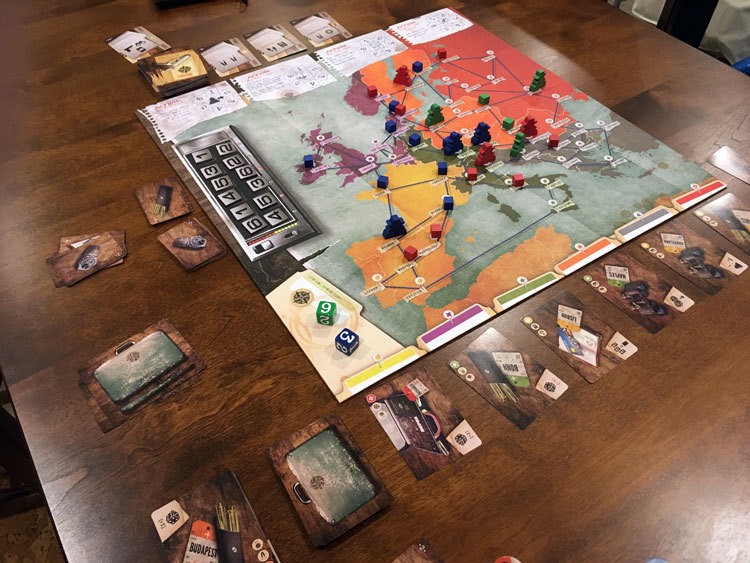
Game Experience:
As players begin assessing the needs of their missions, the complex nature of Covert’s play style instantly becomes apparent. Combining the play of games such as Lords of Waterdeep and Pandemic, players are tasked with gathering resources from multiple locations and moving characters on the board. However, take this concept up to an advanced level and players will see that it’s not enough to just place a worker or move an agent.
Assessing whether to use Agency cards for their various mechanisms is key for players to know whether they should use the equipment or move agents into position. Likewise, the amount of dice to commit to the Cipher tokens to break codes for points or equipment is also crucial. This complex efficiency test is constant and drives a tremendous amount of pressure in the game.
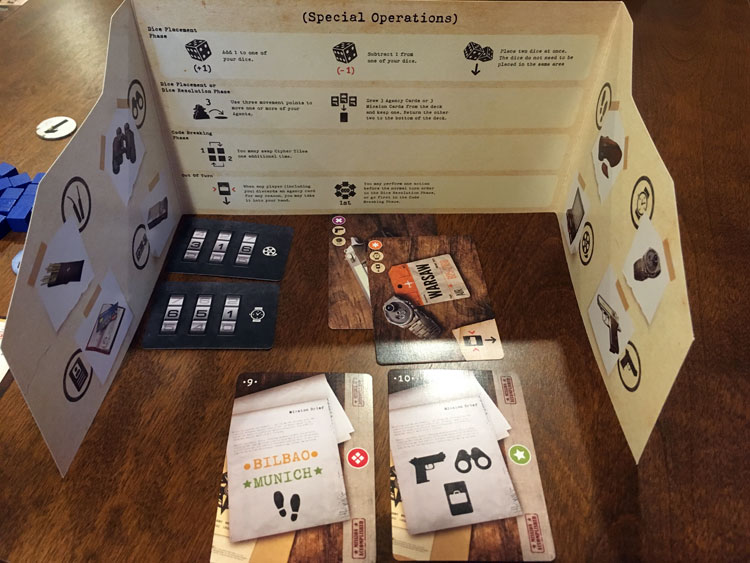
In games like Stone Age, players also gather resources to complete game objectives, and the feeling is similar here. The puzzle nature of getting just the right sequence of steps to complete a mission is omnipresent. Committing all of these moves to memory is the priority in Covert, which also ties directly back to the theme. Because players are never certain what objectives their opponents are after, plans could be foiled at any moment. This highlights Covert as a game for fans of complex systems but who also desire the flair of a fitting theme.
This is not to say that Covert demands the mastermind thinking of an over-arching strategy. Each player’s character provides a special ability that usually focuses which moves a player will utilize, but there is no grand plan to execute. Each round is a calculation to achieve results through the most efficient planning. Often disrupting opponents is a value-add rather than something that is sought out. For example, when allocating dice, because one player’s roll is just as random as any opponent’s, consistently placing dice to block opponents is not feasible. Blocking a crucial move may be opportune, but rarely something planned out.
Where players will notice disappointment is in the replay value. The game state changes constantly due to new Agency and Mission cards laid out. However, the only play style changes that affect players are the special abilities of their characters. Because of this, gameplay feels much the same from session to session. Even with a new character, players still recognize the same patterns of play. But, obviously, Covert is focused on what it does and doing it well. For the game to transcend that would require an expansion; something this reviewer would welcome with high interest.
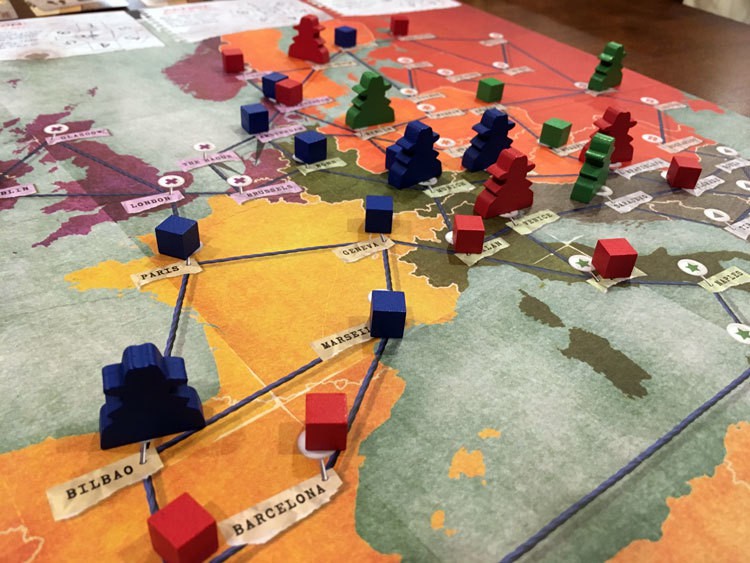
The other thing which will frustrate the planners amongst players is the randomness. Due to bad options in the Mission, Agency, or Code cards, players could be stuck with fewer obvious moves than opponents. This doesn’t last for long and there are many different ways to use the cards or Special Operations tokens that players will find resolution. Still, it can seem arbitrary that one player’s victory was based on getting just the right resources at the right time due to luck.
Another minor point is that the nature of the gameplay can induce analysis paralysis in some players. This is not as bad as other games and is mitigated by the need to continuously plan due to game state changes. This slowness causes some downtime and impatient or expert planners will be made to wait.
Final Thoughts:
Like many games worthy of remembrance, Covert delivers what it offers perfectly. As a competitive puzzle solve and efficiency exercise, it excels. It’s not a game that can be played relentlessly over and over because it will drain players with the sameness of the exercise. However, when the jones for a truly dynamic resource puzzle game comes on, Covert is clearly a title to look for.
If you’d like to pick up a copy of Covert, you can get it for about $50.
Final Score: 4 Stars – A cryptographic, espionage theme matches well with the intense puzzle gameplay to deliver rich albeit similar gameplay with each visit.
 Hits:
Hits:
• Deep puzzle solving and resource management
• Theme and gameplay integration
• Ciphers integrated into product components
Misses:
• Oversized meeples make moving difficult
• Limited variability
• Downtime from analytical play style










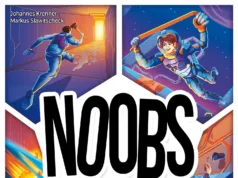













Thanks for the review!
Just to clarify: The start player for the round doesn’t pass counter clockwise. It’s based on when players drop out of the dice placement phase. That decision is a big part of the game as you have to weigh going early in turn order versus getting more actions.
-Kane
Sorry for the misstatement there Kane. I think we never actually used this. I’ll fix it in the review.